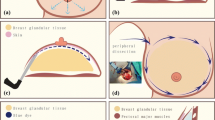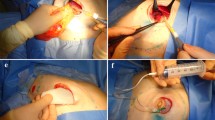Abstract
Background
Although endoscope-assisted surgery has been used for partial mastectomy to improve the cosmetic outcome, this procedure may be somewhat cumbersome, thereby increasing operating time and blood loss. Moreover, the use of expensive disposable endoscopic instruments is required.
Methods
We have performed partial mastectomy via a small periareolar incision (transareolar approach) and/or axillary incision (transaxillary approach) using a wound retractor and bipolar scissors without disposable endoscopic instruments in 58 patients with noninvasive or invasive breast cancer. Axillary lymph node dissection is also performed via small axillary incision using a wound retractor and bipolar scissors.
Results
Average surgical duration was 132 min in transareolar approach and 125 min in transaxillary approach. Average blood loss was 38 and 48 ml, respectively. Postoperatively, the margin of resected breast tissue was histologically confirmed to be negative in 56 of 58 patients (97%) patients. Postoperative appearance of conserved breast was excellent in many patients, unless a large volume of breast tissue was removed.
Conclusion
A wound retractor provides maximum exposure with minimum incision size, thereby allows performance of breast-conserving surgery via a small periareolar and/or axillary incision in patients with a nipple–areola complex that is mobile and not small. It can reduce operating time and blood loss when compared with endoscope-assisted partial mastectomy.





Similar content being viewed by others
References
Yamagata M, Iwai S. Endoscopic treatment for breast cancer. J Jpn Soc Endosc Surg. 1997;2:272–7. (in Japanese with English abstract).
Tamaki Y, Nakano Y, Sekimoto M, Sakita I, Tomita N, Ohue M, et al. Transaxillary endoscopic partial mastectomy for comparatively early-stage breast cancer. Surg Laparosc Endosc. 1998;8:308–12.
Tamaki Y, Sakita I, Miyoshi Y, Sekimoto M, Takiguchi S, Monden M, et al. Transareolar endoscopy-assisted partial mastectomy. Surg Laparosc Endosc. 2001;11:356–62.
Ishiguro S, Nakamura H, Tanaka N, Taniguchi Y, Maeda H, Ito N, et al. Endoscope-assisted breast-conserving surgery. Jpn J Breast Cancer. 1999;14:287–90. (in Japanese).
Lee EK, Kook A-H, Park Y-L, Bae W-G. Endoscopy-assisted breast-conserving surgery for early breast cancer. World J Surg. 2006;30:957–64.
Tamaki Y, Tsukamoto F, Miyoshi Y, Tanji Y, Taguchi T, Noguchi S. Breast overview: video-assisted breast surgery. Biomed Pharmcother. 2002;56:187s–91s.
Noguchi M. Roles of endoscopy-assisted approaches in surgical management of breast cancer: present state of the art and outlook for the future. Trends Cancer Res. 2006;2:85–92.
Klimberg VS. Just because you can? Surg Laparosc Endosc. 2001;11:363.
Applied Medical Resources Co. Applied Alexis wound retractor, product information data, California; 2002.
Author information
Authors and Affiliations
Corresponding author
About this article
Cite this article
Noguchi, M., Inokuchi, M. “Moving window” operation for breast-conserving surgery. Breast Cancer 17, 56–60 (2010). https://doi.org/10.1007/s12282-009-0104-1
Received:
Accepted:
Published:
Issue Date:
DOI: https://doi.org/10.1007/s12282-009-0104-1




